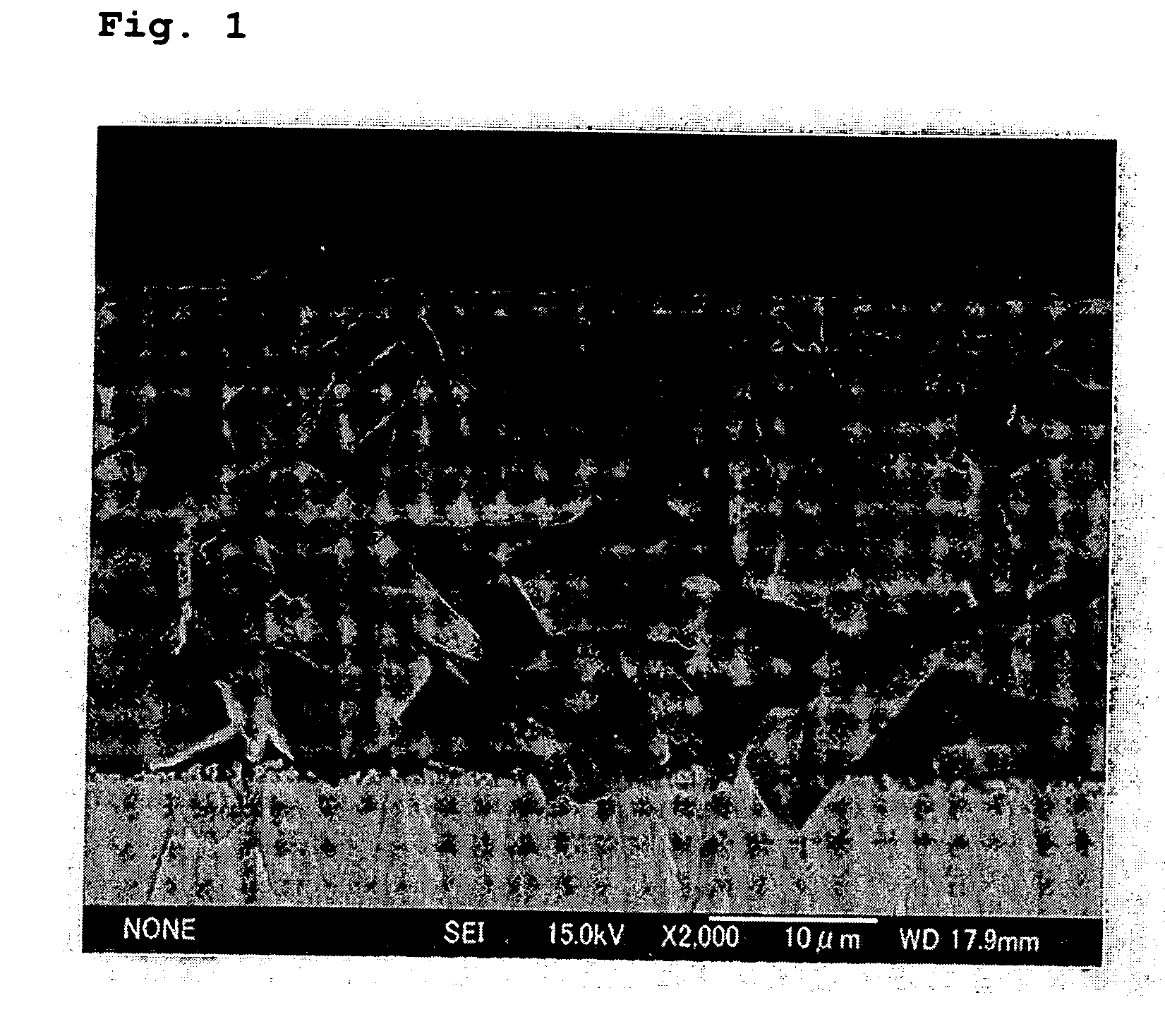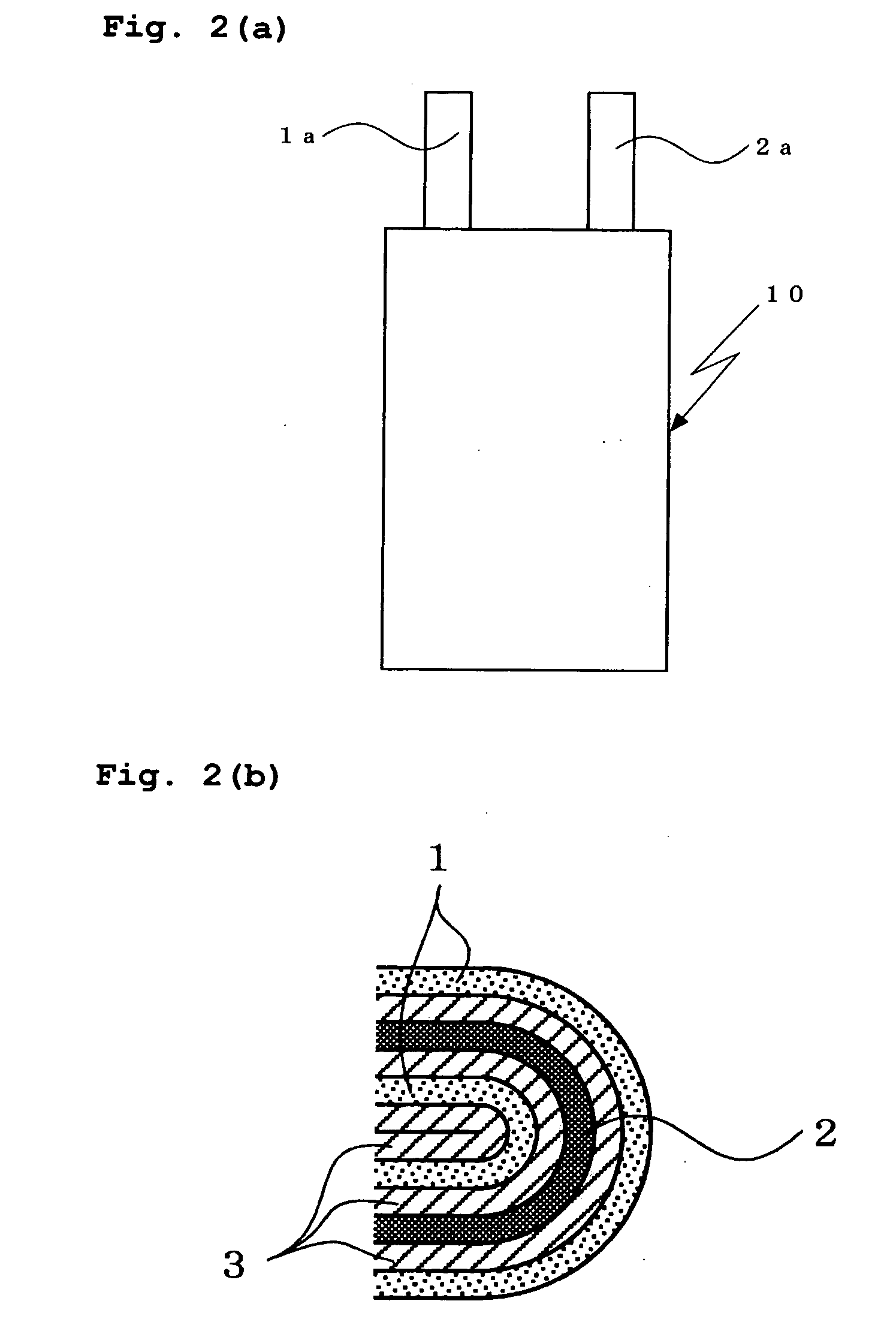Negative electrode for lithium secondary battery, method of manufacturing the electrode, and lithium secondary battery
a lithium secondary battery and negative electrode technology, applied in the field of lithium secondary batteries and negative electrodes for lithium secondary batteries, can solve the problems of deterioration the active material of the negative electrode pulverizing or peeling from the current collector, and the degradation of the charge-discharge cycle performance of the lithium secondary battery, etc., to achieve the effect of improving the adhesion capability of the negative electrode mixture layer to the negative electrode current collector
- Summary
- Abstract
- Description
- Claims
- Application Information
AI Technical Summary
Benefits of technology
Problems solved by technology
Method used
Image
Examples
example 1
[0047]Example 1 uses a negative electrode, a positive electrode, and a non-aqueous electrolyte that were prepared in the following manner.
[0048]Preparation of Negative Electrode
[0049]Silicon powder (purity: 99.9%) having an average particle size of 15 μm was used as the negative electrode active material particles, and a polyimide was used as the binder. The negative electrode active material particles and the binder were mixed at a weight ratio of 9:1, and they were added to N-methyl-2-pyrrolidone. These were mixed together to thus prepare a negative electrode mixture slurry.
[0050]The negative electrode current collector was prepared using a rolled copper alloy foil made of a Cu—Ni—Si—Mg alloy containing 3 wt. % Ni, 0.65 wt. % Si, and 0.15 wt. % Mg. The rolled copper alloy foil had a thickness of 18 μm and a tensile strength of 900 N / mm2. Both sides of the rolled copper alloy foil were roughened by an electrolytic treatment with copper so that the resultant negative electrode curre...
example 2
[0070]In Example 2, in the preparation of the negative electrode, the negative electrode current collector was prepared using a rolled copper alloy foil that was made of a Cu—Ni—Si—Mg alloy containing 3 wt. % Ni, 0.65 wt. % Si, and 0.15 wt. % Mg and that had a thickness of 18 μm and a tensile strength of 900 N / mm2, as in Example 1. However, the rolled copper alloy foil was not subjected to a roughening process. Except for the use of the negative electrode current collector thus prepared, a lithium secondary battery of Example 2 was fabricated in the same manner as described in Example 1 above.
[0071]Then, a cross section of the negative electrode prepared in Example 2 was observed with a scanning electron microscope (SEM). The result is shown in FIG. 5.
[0072]As seen from the figure, in the negative electrode prepared in Example 2 as well, there were several locations in which negative electrode active material particles were partially embedded in the negative electrode current collec...
example 3
[0073]In Example 3, a negative electrode was prepared in the manner described in Example 1, except for the following. In the preparation of the negative electrode mixture slurry, graphite powder having an average particle size of 3 μm was used as the conductive powder. This conductive powder, the foregoing negative electrode active material particles, and the foregoing binder were mixed together at a weight ratio of 87:10:3, to prepare a negative electrode mixture slurry. The negative electrode current collector used was made of a rolled copper alloy foil composed of a Cu—Ni—Si—Mg alloy containing 3 wt. % Ni, 0.65 wt. % Si, and 0.15 wt. % Mg, and the copper alloy foil had a thickness of 18 μm and a tensile strength of 900 N / mm2, as in Example 1. However, the rolled copper alloy foil was not subjected to a roughening process. Except for the use of the just-described negative electrode mixture slurry and the just-described negative electrode current collector, a lithium secondary batt...
PUM
| Property | Measurement | Unit |
|---|---|---|
| tensile strength | aaaaa | aaaaa |
| particle size | aaaaa | aaaaa |
| temperature | aaaaa | aaaaa |
Abstract
Description
Claims
Application Information
 Login to View More
Login to View More - R&D
- Intellectual Property
- Life Sciences
- Materials
- Tech Scout
- Unparalleled Data Quality
- Higher Quality Content
- 60% Fewer Hallucinations
Browse by: Latest US Patents, China's latest patents, Technical Efficacy Thesaurus, Application Domain, Technology Topic, Popular Technical Reports.
© 2025 PatSnap. All rights reserved.Legal|Privacy policy|Modern Slavery Act Transparency Statement|Sitemap|About US| Contact US: help@patsnap.com



